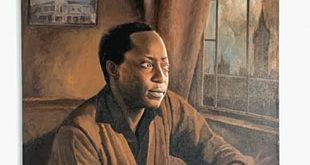
“Learn to listen to silence, and you will discover it is music,” so goes an old African maxim.
The statement connotes an oxymoron as listening to silent sound is inconceivable to many people. It is even more so with something as inanimate as colour. Yet some artists will attempt to have you believe that their colours can elicit sounds which can be heard by any willing listeners. The trick is to believe. Sound lies in the ear of the listener, they say; which eerily sounds like the famous claim that “beauty lies in the eyes of the beholder”.
Edison Mugalu is one Ugandan artist whose name has become indelibly associated with sound in art. He dabbles in poetry writing and reading music, and videography. His running exhibition at Umoja Gallery in Kamwokya, for example, is themed, “Heartbeat” because, he says, the paintings on show are “the sound of life”.
“It is only colour that enters the depth of my heart, and on its journey, carries stories to turn into paintings right away with the help of palettes, acrylics, canvases, and brushes,” he says.
He enforces the phenomenon of life with a pulsating palette of brilliant colours that create lively highlights in the paintings. He paints stories of real life happenings; of women queuing up for water with yellow jerry cans, a common scene in Uganda’s rural and urban settings; of a mother walking with her son on a dusty road, lined with colourful trees and flowers with several other souls disappearing in the distance.

Mugalu’s colors recede too, as if returning to some deep recess of his embodiment of life. He is able to inspire a colour scheme that evokes the very spirit of silent life. He renders his subjects in abstract expressionism, with limited reference to forms in the real world. The colours too radiate a foggy and dusty appearance – a rush of palette knife and bold brush strokes in tandem. His moves on the canvas are rather indecisive and paly in nature. That is Mugalu’s story of the silent sound of life in Uganda. Or is it?
Is it not the case that some observers of this art might be sound-deaf (my word), as in the proverbial colour-blind? Or, is it not that some people would prefer silent silence while viewing the art; especially, after the deafening sounds that typify Kampala?
The trouble with silence is that it can be disconcerting and can make people feel uncomfortable and alone. Many people feel the need to fill the void with needless chatter, with TV, radio music, any noise.
Equally, however, it said silence has energy to it like no other. That it has the power to get people to think and to act, and it can help slow the mind, and is a powerful ally in the business of comprehending deep intellectual thought.
Mugalu says when paints, he does not only do it from the bottom of his heart but he follows his heart beating “slowly by slowly,” as he puts it. Hopefully, visitors to Umoja Gallery in Kampala between February 11 and March 11 will feel the silent sound of his heartbeat.
****
editor@independent.co.ug
 The Independent Uganda: You get the Truth we Pay the Price
The Independent Uganda: You get the Truth we Pay the Price





